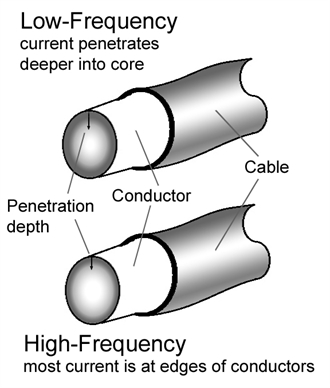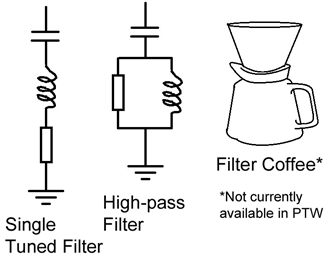How high harmonics herald harm
This month’s topic is all about power system harmonics, the dangers they pose, and how CEE can help you to mitigate them on your system. Harmonics are a problem on any AC transmission or distribution system; they are essentially high-frequency currents and voltages which distort the fundamental system current and voltage waveforms.

What’s the harm?
Heating effects: Cables carrying alternating current generally have their current-carrying capacity expressed at 50 or 60Hz (the fundamental, or nominal, frequency). This is because a cable’s current carrying capacity is lower for high-frequency currents than for low-frequency currents. The majority of current in a cable is actually carried by the outermost edge of the conductors, in a process known as the skin effect. The distance from the edge of the conductor to the point where current flow is 37% of the surface current is known as the skin depth or penetration depth. The higher the frequency of the current, the lower the penetration depth; therefore overall current capacity is lower because more of the current is being forced to the extremities of the cable. Where high frequency harmonics exist, they can cause unexpected heating effects since the outer edges of the conductors will be carrying more current than intended.
Partial discharge and stray capacitances: Harmonics do not cause stray capacitances but they do exploit them. Minute gaps between conductors or air gaps within cable and motor insulation all have a capacitance. Since capacitive impedance is inversely proportional to frequency, these stray capacitances have minimal effect at nominal system frequency. However, high-frequency harmonics experience a much lower capacitive impedance which in turn allows these stray capacitances to discharge. Discharges not only cause spikes in current and voltage waveforms, but can also produce dangerous local heating effects and may cause welding of relay contacts or the premature failure of switches.
High neutral currents: As noted in the February newsletter, star-connected three-phase AC systems are particularly vulnerable to triplet-order harmonics. Since the current in each phase is normally displaced by a third of a cycle, “peaks” and “troughs” in the three phase currents should sum to zero at the neutral point. Triplet-order harmonics break this rule since, when displaced by a third of a cycle, the “peaks” and “troughs” continue to align. Therefore triplet-order harmonics add together to produce a positive current at the neutral point. If the system neutral is not rated high enough to cope with these currents, it may overheat. Protection schemes incorporating Current Transformers (CTs) in the neutral may also experience spurious trips.
High neutral currents: As noted in the February newsletter, star-connected three-phase AC systems are particularly vulnerable to triplet-order harmonics. Since the current in each phase is normally displaced by a third of a cycle, “peaks” and “troughs” in the three phase currents should sum to zero at the neutral point. Triplet-order harmonics break this rule since, when displaced by a third of a cycle, the “peaks” and “troughs” continue to align. Therefore triplet-order harmonics add together to produce a positive current at the neutral point. If the system neutral is not rated high enough to cope with these currents, it may overheat. Protection schemes incorporating Current Transformers (CTs) in the neutral may also experience spurious trips.
How can I mitigate harmonics?
CEE recommends the PTW software “Hi-Wave” module to calculate system harmonics. Use the library of typical harmonic sources (such as 6- and 12-pulse rectifiers, over-excited transformers etc.) or enter your own harmonic data for a known harmonic source. Once a problem harmonic has been identified, PTW can then be used to model various types of filter to reduce harmonic currents and voltages to a manageable level:

- Single tuned filter: A simple filter designed to reduce the impedance between phase and earth conductors at one specific frequency. In this way, any currents oscillating at that particular frequency (harmonic) are conducted to ground and are effectively removed from the system.
- High-pass tuned filter: Similar to the single tuned filter in that these devices are tuned to operate at one frequency. However, the high-pass type of filter helps to mitigate some other harmonics either side of the tuned frequency.
Harmonic currents are often created at the end points of a distribution system, so designers often try to prevent these harmonics from affecting the main power supply (utility). Delta/star transformers are useful because triplet-order harmonics do not affect delta-connected power systems (there is no neutral conductor, so there cannot be a neutral current!). It is important to note however that the harmonics will still be present on the secondary (star-wound) side of the transformer; with all the associated problems! In particular, the transformer power rating must be high enough to cope with unusually high secondary winding currents caused by harmonics.
If the distribution system has several identical sources of harmonic currents, three-winding transformers can be used to cancel out some harmonics on the primary / HV side by applying different phase shifts to the LV (secondary and tertiary) windings. We have created this helpful guide, modelled in PTW, to illustrate how this process works.
If mitigating harmonic currents isn’t a viable option, some protection relays are de-sensitised to certain typical harmonic currents. This is often the case where harmonics occur for only brief periods on the system. CEE’s NP900 range of relays can be configured to block overcurrent protection during short-duration harmonic inrush currents at specific harmonic (for example the 2nd and 5th harmonics since these commonly occur upon transformer energisation). They can also initiate a trip if a particular harmonic current exceeds a specified limit and can measure system harmonics (up to the 31st harmonic) in real-time.
Have harmonic headaches? Hi-Wave helps.
If the distribution system has several identical sources of harmonic currents, three-winding transformers can be used to cancel out some harmonics on the primary / HV side by applying different phase shifts to the LV (secondary and tertiary) windings. We have created this helpful guide, modelled in PTW, to illustrate how this process works.
If mitigating harmonic currents isn’t a viable option, some protection relays are de-sensitised to certain typical harmonic currents. This is often the case where harmonics occur for only brief periods on the system. CEE’s NP900 range of relays can be configured to block overcurrent protection during short-duration harmonic inrush currents at specific harmonic (for example the 2nd and 5th harmonics since these commonly occur upon transformer energisation). They can also initiate a trip if a particular harmonic current exceeds a specified limit and can measure system harmonics (up to the 31st harmonic) in real-time.
Have harmonic headaches? Hi-Wave helps.